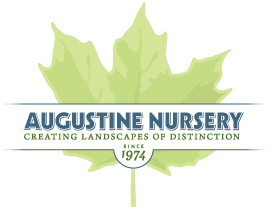Planting & Caring for Shrubs

Learn how to plant and care for shrubs with complete instructions and helpful tips to get the most out of your landscape.
- Measure the depth of the root ball so that the top of it will sit 1-inch higher than ground level, but never lower.
- Dig a hole that is 1–1½ times larger than the ball or container.
- Center the root ball in the hole and untie or cut away the top ⅓ of burlap by either folding it back or trimming it off. If the plant came in a container, first remove the container then make a series of four vertical scores to the soil/root mass at a depth of about ¼-inch, at 3, 6, 9 and 12 o’clock positions.
- Clean the excavated soil of rocks and other debris.
- Make a mixture (enough to back-fill the hole) of 50% cleaned, excavated soil and 50% compost (peat moss/fertilizer/compost).
- Back-fill the plant half way with the soil mixture, then water thoroughly. Continue to back-fill with the remaining excavated soil while leaving room for an approximately 3-inch deep saucer of mulch to completely surround the plant.
- Water thoroughly.
GENERAL MAINTENANCE TIPS
Watering Trees and Shrubs
After planting, water trees and shrubs 2–3 times per week
for the rest of the growing season. Each tree or shrub should receive 1–10 gallons of water depending on its size.
Note: In times of stress or extreme heat, increase amount of water.
Root Feeding/By June 30th
For acid loving plants use Holly-tone®. All other plants should
be fed with specially designed fertilizer stakes.
Foliage Feeding/As Early As April 30th. For acid loving plants, apply Miracid® every 7–10 days until mid-August. All others apply Miracle-Gro® every 7–10 days until mid-August.
General Pruning and Trimming
For flowering trees and shrubs, the rule of thumb is to cut them back after they have flowered.
For evergreens, pruning should be done after the new growth hardens, which is usually mid-July up to November.
Anti-desiccant
As a treatment to reduce moisture loss due to winterkill, windburn, drought, etc. all plants should be treated with an anti-desiccant or anti-transpirant. Suggested applications:
All newly planted material
s, Annual fall application
Insect Infestation
A watchful eye should be kept for any signs of an infestation. If an infestation seems to be occurring the problem should be identified and addressed immediately.
Tree Stakes
Stake deciduous trees that are 2–2½ inch in diameter and larger. Stake evergreen trees 5–6 feet tall and larger. Tree stakes, wire and hose should be removed after 1 year.

